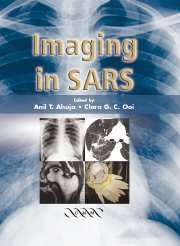Book contents
- Frontmatter
- Contents
- Contributors
- Preface
- 1 The Epidemiology of Severe Acute Respiratory Syndrome: A Global Perspective
- 2 The Role of Emergency Medicine in Screening SARS Patients
- 3 Severe Acute Respiratory Syndrome Outbreak in a University Hospital in Hong Kong
- 4 Imaging of Pneumonias
- 5 The Role of Chest Radiographs in the Diagnosis of SARS
- 6 Chest Radiography: Clinical Correlation and Its Role in the Management of Severe Acute Respiratory Syndrome
- 7 The Role of High-Resolution Computed Tomography in Diagnosis of SARS
- 8 The Role of Imaging in the Follow-up of SARS
- 9 Treatment of Severe Acute Respiratory Syndrome
- 10 SARS in the Intensive Care Unit
- 11 Imaging of Pneumonia in Children
- 12 Imaging and Clinical Management of Paediatric SARS
- 13 Imaging of SARS in North America
- 14 Radiographers' Perspective in the Outbreak of SARS
- 15 Implementation of Measures to Prevent the Spread of SARS in a Radiology Department
- 16 Aftermath of SARS
- 17 Update on Severe Acute Respiratory Syndrome
- Index
4 - Imaging of Pneumonias
Published online by Cambridge University Press: 27 October 2009
- Frontmatter
- Contents
- Contributors
- Preface
- 1 The Epidemiology of Severe Acute Respiratory Syndrome: A Global Perspective
- 2 The Role of Emergency Medicine in Screening SARS Patients
- 3 Severe Acute Respiratory Syndrome Outbreak in a University Hospital in Hong Kong
- 4 Imaging of Pneumonias
- 5 The Role of Chest Radiographs in the Diagnosis of SARS
- 6 Chest Radiography: Clinical Correlation and Its Role in the Management of Severe Acute Respiratory Syndrome
- 7 The Role of High-Resolution Computed Tomography in Diagnosis of SARS
- 8 The Role of Imaging in the Follow-up of SARS
- 9 Treatment of Severe Acute Respiratory Syndrome
- 10 SARS in the Intensive Care Unit
- 11 Imaging of Pneumonia in Children
- 12 Imaging and Clinical Management of Paediatric SARS
- 13 Imaging of SARS in North America
- 14 Radiographers' Perspective in the Outbreak of SARS
- 15 Implementation of Measures to Prevent the Spread of SARS in a Radiology Department
- 16 Aftermath of SARS
- 17 Update on Severe Acute Respiratory Syndrome
- Index
Summary
Introduction
Pneumonia is the sixth most common cause of death, and the leading cause of death from infection in the US. The diagnosis of pneumonia requires combination of careful clinical evaluation, appropriate laboratory investigations including microbiological tests and radiological confirmation of pneumonia. The chest radiograph is the cornerstone of radiological diagnosis, and the imaging modality of choice in establishing the presence of pneumonia, including its severity and extent. The efficacy of the clinical examination in detecting pneumonia is acknowledged to be less sensitive, with auscultatory evidence of pneumonia reported to be absent in a quarter of patients. In addition, Osmer and Cole found that stethoscopic findings were often not in concordance with radiographic findings.
As this book deals with imaging of severe acute respiratory syndrome (SARS), a predominantly pneumonic illness, this chapter serves to provide a background to the radiological appearances of pneumonias of different aetiology. The main radiographic feature of any pneumonia is consolidation, defined as an opacity that obscures vascular markings, which can range from small ill-defined areas to larger areas involving one or more lobes. The pulmonary acinus is the smallest airspace unit visible on the radiograph (4-9 mm in diameter) and is that part of the lung distal to the terminal bronchiole including respiratory bronchioles, alveolar ducts and alveolar sacs.
- Type
- Chapter
- Information
- Imaging in SARS , pp. 33 - 52Publisher: Cambridge University PressPrint publication year: 2004

